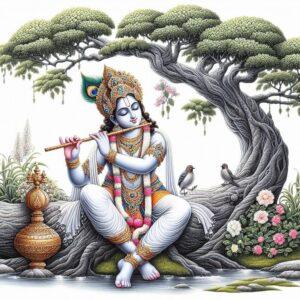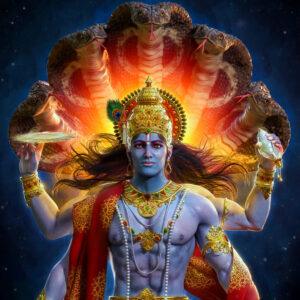
In Hindu traditions, Vishnu holds a special place as a principal deity. Revered as the preserver and protector of the universe, Vishnu’s tales and teachings have shaped Hindu beliefs and cultural practices for generations. Exploring Vishnu’s birth and origins provides insights into the depths of Hindu mythology and the cosmic roles played by divine beings like Brahma, Vishnu, and Shiva in the Trimurti.
The Concept of Birth in Hindu Mythology
Hindu mythology presents a unique perspective on the birth of divine entities, often transcending human-like birth processes. These narratives serve as symbolic representations conveying moral and philosophical lessons. Vishnu’s birth, as portrayed in texts like the Puranas and Vedas, emphasizes divine emergence rather than traditional birth, highlighting Vishnu’s eternal existence and cyclical presence throughout different Yugas (epochs). These stories underscore the symbolic elements behind divine births, offering profound teachings through allegory.
Vishnu’s origin stories in ancient scriptures like the Vishnu Purana depict his emergence from the cosmic ocean. Associated with primordial waters and the lotus, these symbols represent purity and divine creation. The cosmic serpent Ananta-Shesha, serving as Vishnu’s resting place, symbolizes infinity and cosmic balance. Through various avatars (incarnations), Vishnu maintains dharma (cosmic order), demonstrating adaptability and dedication to preserving universal harmony.
Vishnu’s Origins and Cosmic Role
In Hindu mythology, Vishnu stands as a principal deity, revered as the Preserver. Alongside Brahma, the Creator, and Shiva, the Destroyer, Vishnu completes the divine trinity known as the Trimurti. His role is to sustain cosmic order, or dharma, a crucial task in maintaining balance throughout the universe.
Vishnu’s origin story is rich with symbolism and cultural significance. Ancient texts, including the Vishnu Purana, narrate his emergence from the cosmic ocean. This tale is connected to the “Samudra Manthan,” or the churning of the ocean of milk, a myth symbolizing the struggle between gods and demons for amrita, the nectar of immortality. Vishnu’s intervention during this event ensures the preservation of dharma.
While not a prominent deity in the early Vedic period, Vishnu’s importance grew over time. His avatars, particularly Vamana, are celebrated in various myths. Vamana’s three strides across the universe exemplify Vishnu’s ability to maintain cosmic harmony even in seemingly insignificant forms.
For more in-depth information on Lord Vishnu’s origins and significance, refer to resources such as: Vishnu Temples: Stories and Beliefs of Devotion and Hinduism: A Complete History and Origin.
Symbolism in Vishnu’s Myths
Vishnu’s stories are replete with symbolic meaning. The lotus, often associated with him, represents purity and divine birth. Emerging from primordial waters signifies purity and creation. Ananta-Shesha, the cosmic serpent and Vishnu’s resting place, symbolizes infinity and balance. Vishnu’s blue skin represents the infinite sky and the vastness of the universe.
His avatars illustrate adaptability, addressing cosmic or earthly challenges to uphold dharma. Notable avatars like Rama and Krishna have significantly influenced Hindu culture and religious practices. For a deeper dive into the significance of these avatars, explore resources like Valmiki Ramayana: Author, Poet, Sage and Ravana Reexamined: A Scholar or a Villain?
Vishnu in Hindu Culture
Vishnu’s influence extends beyond mythology, deeply impacting Hindu cultural practices. Festivals like Diwali and Janmashtami celebrate his legacy. Temples dedicated to Vishnu are scattered across India, each reflecting his grandeur and spiritual significance. Daily prayers, chants, and rituals often incorporate Vishnu’s teachings, emphasizing his omnipresence in Hindu devotion.
Understanding Vishnu’s origins enriches one’s spiritual journey. His tales are not merely stories but lessons in morality and ethics, offering guidance for contemporary life. Embracing these narratives deepens appreciation for Hindu cultural heritage, preserving its rich tapestry for future generations.
How Poojn.in Helps You Honor Lord Vishnu
At Poojn.in, we offer authentic puja items to facilitate your worship of Lord Vishnu with proper devotion:
- Complete Vishnu Puja Sets: Pre-assembled kits containing all the essential items for Vishnu worship, ensuring a convenient and complete puja experience.
- Pure Brass Idols: Traditional Vishnu murtis in various sizes and poses, crafted with meticulous detail to serve as a focal point for your devotion. Laddoo Gopal Brass Murti
- Panchdhatu Items: Sacred items made from five metals, imbued with traditional significance and ideal for ritual use, enhancing the authenticity of your puja.
- Tulsi Mala: Holy basil beads for japa (recitation) and meditation, promoting spiritual focus and connection with Lord Vishnu. Five Mukhi Rudraksha Mala
- Pure Copper Items: Ritual vessels and items preferred for Vishnu puja, crafted from pure copper for its traditional and auspicious properties.
- Shankh (Conch): Sacred conches for producing ritual sounds during worship, adding an element of traditional sanctity to your puja.
- Yellow Vastra: Traditional yellow cloth offerings, symbolizing purity and devotion, to adorn Lord Vishnu’s idol.
- Pure Ghee: For deepam (lighting lamps) and other ritual offerings, enhancing the sanctity and purity of your puja. Pure Camphor
- Tulsi Leaves: Fresh and dried holy basil leaves for offerings, symbolizing purity and devotion to Lord Vishnu.
All items at Poojn.in are sourced from trusted vendors who adhere to traditional manufacturing methods. We ensure each product meets religious requirements for puja use. Our puja items are carefully packed and delivered across India. Visit www.poojn.in to explore our complete collection of Vishnu puja items. We offer detailed product descriptions and expert guidance to assist you in selecting the right items for your worship needs.
Embracing Vishnu’s Legacy
Vishnu’s profound presence in Hindu mythology and culture offers more than just ancient tales. These stories provide timeless lessons in maintaining balance and upholding righteousness. Vishnu’s role as the Preserver emphasizes the importance of nurturing harmony within ourselves and the world around us.
Whether through grand festival celebrations or quiet moments of daily prayer, Vishnu’s teachings continue to guide and inspire. His avatars and symbols serve as reminders of the divine’s adaptability and the enduring quest for dharma. By embracing these narratives, we honor our rich cultural heritage and ensure its vibrant continuation for future generations.
Understanding Vishnu’s origins and significance connects us with our past and provides wisdom for navigating the complexities of modern life. Let us carry forward this legacy, cherishing the divine stories that shape our values and traditions.
FAQs on Vishnu’s Birth and Origins: Ancient Hindu Beliefs
How was Vishnu born? In ancient Hindu beliefs, Vishnu is not born in the conventional sense. He is considered eternal, without beginning or end. Stories describe him emerging from the cosmic ocean on the serpent Ananta, ready to create and preserve the universe.
How did Vishnu come into existence? According to Hindu texts, Vishnu is self-existent, a part of the Holy Trinity with Brahma and Shiva. He is believed to have appeared from the supreme being, Brahman, the source of all creation.
Where did Vishnu come from? Vishnu is said to rest on the cosmic waters, reclining on the serpent Ananta. From this position, he oversees the universe, maintaining balance and order. The Puranas describe him rising from these waters during creation.
What role does Vishnu play in Hindu beliefs? Vishnu is the preserver and protector of the universe, ensuring the sustenance of creation and supporting righteousness (dharma). He incarnates in various forms, known as avatars, like Rama and Krishna, to restore cosmic order.
Why is Vishnu often depicted with a conch and discus? The conch (shankha) symbolizes the sound of creation, while the discus (chakra) represents the mind and power. These items reflect Vishnu’s role as protector and preserver, using wisdom and might to maintain order. Maha Vishnu Incense Sticks
What is the significance of Ananta, the serpent, in Vishnu’s story? Ananta, or Shesha, symbolizes eternity and infinity. Vishnu resting on Ananta signifies the eternal nature of the universe and its cycles, reflecting Vishnu’s constant and unending presence.
How do Vishnu’s avatars relate to his origins? Vishnu’s avatars, like Rama and Krishna, are manifestations of his energy and purpose. They emerge when the universe requires balance and guidance, demonstrating Vishnu’s ever-present and adaptable essence.


